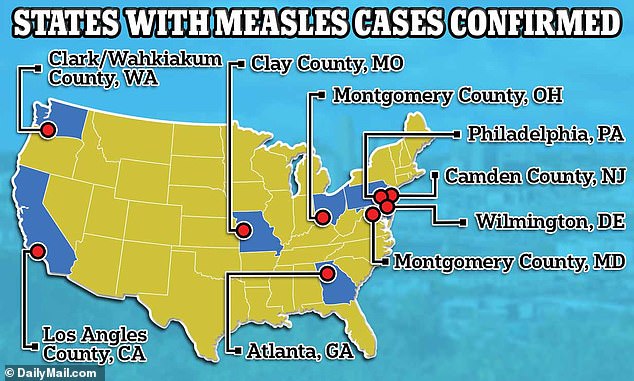Were you at the Cincinnati airport on January 27? You could have gotten measles, health officials say
- The Ohio Department of Health said an infected child passed through Terminal A
- It is working with the CDC to identify people who may have been exposed
- READ MORE: Is America Facing its Worst Measles Outbreak in Years?
Travelers at Cincinnati Airport in Kentucky may have been exposed to measles, health officials warn.
The Ohio Department of Health issued this notice after a Montgomery County child infected with the deadly disease passed through Terminal A of Cincinnati/Northern Kentucky International Airport last week.
Those who traveled through that area on January 27 between 5:00 PM and 9:00 PM and between 8:30 PM and 11:30 PM may have been exposed.
“ODH is working with the Centers for Disease Control and Prevention (CDC) and other state and local health officials to identify people who may have been exposed, including contacting potentially exposed passengers on specific flights,” the agency said.
Travelers at Cincinnati Airport in Kentucky may have been exposed to measles, health officials warn

Cases of measles have been recorded in the highlighted states this year
They said the warning was “out of an abundance of caution.” It is linked to Ohio’s first case of 2024: the child from Montgomery County.
Measles is highly contagious. Children infected with the virus that causes the condition can spread the virus to others up to three weeks before developing symptoms.
According to a news release from Dayton & Montgomery County, the measles virus can live in the air for up to two hours after an infected person leaves the room.
Nine out of ten unvaccinated children exposed to measles will become infected.
Symptoms typically appear between seven to 14 days after contact with the virus.
It can cause a high fever that can be life-threatening, a red rash, coughing, fatigue and watery eyes.
The rash usually starts on the face and behind the ears before spreading to the rest of the body, with the spots of the rash sometimes raising and joining together to form blotchy patches. They usually don’t itch.
On white skin the rash looks brown, but on brown and black skin it can be harder to see.
In some cases, the infection can also cause sensitivity to light, pneumonia, and swelling of the brain.
One in five children who become infected end up in hospital and one in fifteen develops serious complications such as meningitis or sepsis. For every thousand children who contract measles, one or two will die from the disease.
About five percent of children with measles can develop pneumonia, which is the most common cause of death in young children with measles.
In addition, about one in a thousand children who contract measles may experience brain swelling or encephalitis, characterized by swelling of the brain, leading to convulsions and possible consequences such as deafness or intellectual disability.
Measles – a disease that until recently was thought to be consigned to history – is making a resurgence in the US.
Georgia confirmed its first infected patient in nearly four years last month, making it the fifth state to report cases of the ultra-contagious virus so far this year.
Delaware, Washington state, NewJersey and Pennsylvania has also reported cases, and doctors fear this is just the tip of the iceberg, with more measles cases expected to emerge throughout 2024.
At least 15 total cases have been reported this year alone, while 41 were confirmed last year. There are indications that vaccination rates among children, the population at highest risk of disease, have reached a new low.
Nationally, nearly four percent of children entering kindergarten had not been vaccinated against MMR, the lowest rate since the 2013-2014 school year, raising the risk of a tidal wave of infections.
